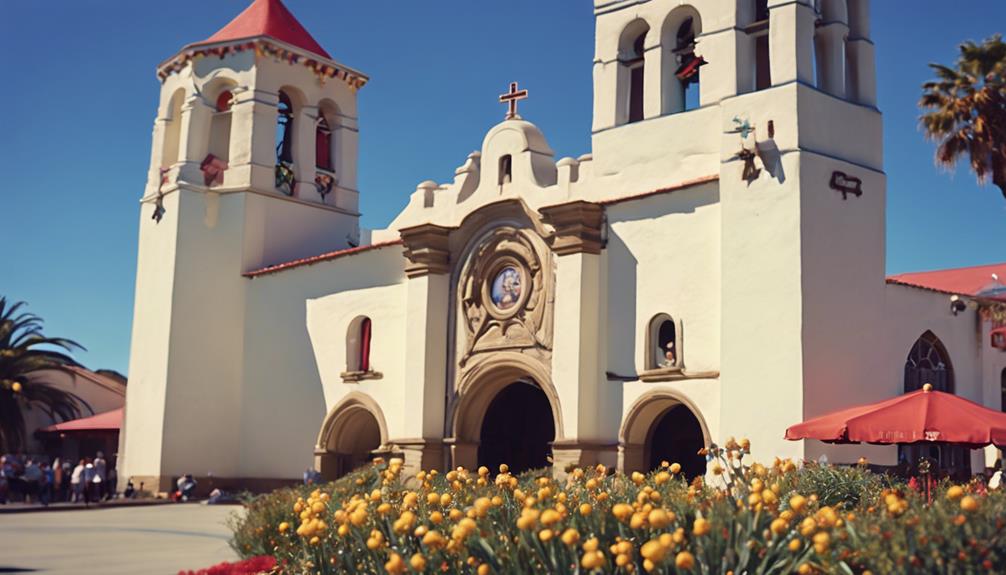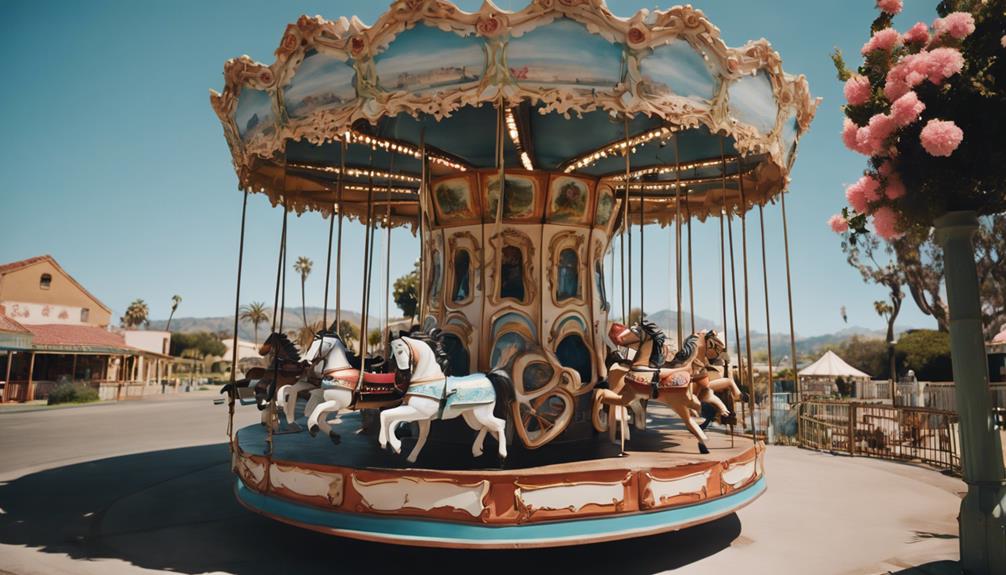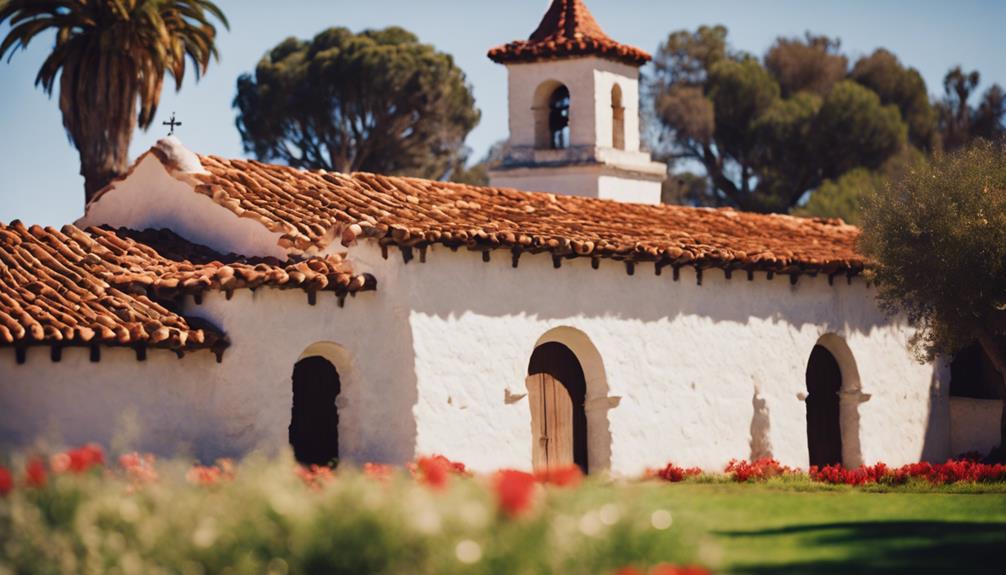Explore the historical significance of Mission San Luis Obispo De Tolosa, founded in 1772 by Father Junipero Serra. This well-preserved landmark showcases a unique blend of Spanish and Moorish architecture, featuring adobe walls, red-tiled roofs, and a central courtyard. Immerse yourself in the cultural legacy intertwined with the Chumash Native Peoples, Civilian Conservation Corps, and John C. Fremont. Meanwhile, at Midway Magic, experience classic carnival fun with rides, games, and entertainment for all ages. From Ferris wheels to funhouse mirrors, this vibrant area offers a mix of traditional and modern attractions, perfect for creating cherished memories with loved ones.
Key Takeaways
- Mission San Luis Obispo De Tolosa: Historic Spanish mission with preserved architecture and cultural significance.
- Cultural Significance: Shapes community identity, vital in early colonization, engages in preservation efforts.
- Preservation Efforts: Emphasize architectural and historical importance, engage in initiatives like the Historic American Landscapes Survey.
- Midway Magic Attractions: Offers classic carnival fun, rides, games, and entertainment suitable for all ages.
- Vibrant Experience: Provides lively atmosphere, live entertainment, and lasting memories for visitors.
Mission San Luis Obispo De Tolosa History
Explore the rich history of Mission San Luis Obispo De Tolosa, founded in 1772 by Father Junipero Serra, a significant State Historical Landmark in California. This mission, located in San Luis Obispo, is part of the Spanish colonial chain of missions established in California. Its architectural significance lies in being a well-preserved example of early California mission architecture. Mission San Luis Obispo de Tolosa continues to serve as an active parish church and remains a popular historical and cultural site in the region.
The mission's history is deeply intertwined with the early European habitation of California, as evidenced by its designation as State Historical Landmark No. 325. Its establishment by Father Junipero Serra marks an important moment in the mission's founding and its subsequent role in the state's history.
Today, visitors can experience firsthand the legacy of Mission San Luis Obispo De Tolosa, immersing themselves in the historical significance of this iconic site.
Father Junipero Serra's Legacy

Father Junipero Serra's legacy is deeply intertwined with the history of Mission San Luis Obispo De Tolosa, reflecting his pivotal role in California's early European settlement efforts.
Founded in 1772 as part of the California mission chain, Mission San Luis Obispo de Tolosa stands as State Historical Landmark No. 325 since 1966, underscoring its historical significance.
Father Serra, a key figure in the state's early European colonization, established missions with the aim of converting Native Americans to Christianity, impacting indigenous groups like the Chumash Native Peoples in San Luis Obispo. His mission activities left a lasting mark on the region's cultural landscape.
Additionally, the history and legacy of Mission San Luis Obispo de Tolosa also connect to the Civilian Conservation Corps (CCC) and explorer John C. Fremont, further enriching the narrative of this historical site.
Father Junipero Serra's contributions continue to shape the understanding of California's early history through the enduring presence of Mission San Luis Obispo de Tolosa.
Cultural Significance of Missions

Mission San Luis Obispo de Tolosa's cultural significance lies in its historical impact, preservation of traditions, and local community involvement.
As a key player in California's early European settlement, the mission represents a blend of Spanish colonial architecture and native Chumash influences.
Efforts by the Civilian Conservation Corps and figures like John C. Fremont have contributed to the preservation and restoration of this iconic landmark.
Historical Impact of Missions
The historical impact of San Luis Obispo's missions on the region's cultural landscape remains deeply significant, shaping the community's identity and traditions to this day. Mission San Luis Obispo de Tolosa, one of the key missions in the area, played a vital role in California's early European colonization and the propagation of Christianity among the Native American populations. These missions functioned not only as places of worship but also as centers for agriculture, education, and the conversion of indigenous peoples.
These missions' cultural significance lies in their stunning architectural designs, historical artifacts, and the narratives of the missionaries and Native inhabitants who resided and toiled there. Their influence continues to resonate through the local communities, art forms, traditions, and religious practices in the region.
Today, efforts are being made to preserve and highlight the historical and cultural importance of these missions for the benefit of future generations.
Preservation of Traditions
In preserving the traditions associated with Mission San Luis Obispo de Tolosa, the community actively engages in safeguarding the cultural heritage and historical significance of these iconic landmarks. Founded in 1772 by Father Junipero Serra, this mission played an important role in California's early European settlement. Designated as State Historical Landmark No. 325, Mission San Luis Obispo de Tolosa holds great significance in preserving the region's cultural heritage.
This mission serves as a symbol of the interactions between Spanish missionaries, Chumash Native Peoples, and the Civilian Conservation Corps, showcasing a rich history that shaped the area. The preservation efforts of Mission San Luis Obispo de Tolosa emphasize its architectural and historical importance within the California mission chain.
Initiatives such as the Historic American Landscapes Survey play a significant role in documenting and maintaining the cultural significance and historical value of Mission San Luis Obispo de Tolosa for future generations.
Local Community Involvement
Engage with the local community in San Luis Obispo to discover the vibrant cultural significance surrounding Mission San Luis Obispo de Tolosa. This mission holds a special place in the hearts of residents, who actively participate in preserving its history and promoting its importance. Through educational programs, volunteer opportunities, and cultural events, the community showcases its dedication to the mission's legacy.
Local residents take pride in organizing events and sharing the rich history of Mission San Luis Obispo de Tolosa with visitors. The mission serves as a focal point for community gatherings, celebrations, and religious ceremonies, highlighting its enduring cultural significance. This involvement not only preserves the mission as a cherished landmark but also contributes to the area's cultural heritage.
Midway Magic Attractions

Step right into a world of whimsical delight and excitement at San Luis Obispo's Midway Magic attractions. The vibrant Midway Magic area offers a thrilling array of rides, games, and entertainment suitable for all ages.
Immerse yourself in classic carnival fun as you indulge in sweet cotton candy, buttery popcorn, and try your luck at the colorful midway games. The atmosphere is alive with bright lights, lively music, and the contagious sound of laughter filling the air.
Families can explore a variety of attractions, from traditional Ferris wheels and carousels to the whimsical funhouse mirrors that distort reality in amusing ways. The Midway Magic attractions provide a perfect blend of nostalgia and festivity, creating an ideal setting for making cherished memories with loved ones.
Nostalgic Charm of Midway

Discover the enchanting allure of the Midway's nostalgic charm as you wander through a blend of traditional fair experiences with a modern twist at San Luis Obispo.
The Midway at the SLO County Fairgrounds offers classic carnival attractions and rides suitable for all ages. Step into a world where games, food vendors, and live entertainment come together to create a lively atmosphere perfect for family fun or thrill-seekers looking for excitement.
The Midway's ambiance harkens back to the charm of yesteryears, providing visitors with a sense of nostalgia while still offering a contemporary twist on traditional fair experiences. Whether you're enjoying the colorful lights, the sounds of laughter, or the smell of delicious fair food, the Midway at San Luis Obispo is sure to leave you with lasting memories of a festive and vibrant setting.
Entertainment Offerings in Midway

Amidst the vibrant ambiance of the Midway at San Luis Obispo, you'll find a delightful array of entertainment offerings to captivate your senses. Here are some highlights of what you can experience:
- Thrilling Rides: From classic Ferris wheels to heart-pounding roller coasters, the Midway has a variety of rides to satisfy your craving for excitement.
- Carnival Games: Test your skills and win prizes at the numerous carnival games scattered throughout the area.
- Live Performances: Immerse yourself in the magic of live entertainment with talented performers showcasing their skills in music, dance, and more.
Whether you're enjoying some delicious fair food, browsing through unique handmade crafts, or simply taking in the vibrant atmosphere with colorful lights and lively music, the Midway offers a perfect blend of fun and entertainment for families and friends to create lasting memories together.
Historical Tapestry of the Region

The historical tapestry of the San Luis Obispo region weaves together intricate threads of mission architecture influence, cultural legacy preservation, and indigenous community connections.
Mission San Luis Obispo de Tolosa stands as a reflection of the Spanish colonial era, offering a window into California's past.
Notable figures like John C. Fremont have also left their mark, enriching the area's heritage with diverse layers of history.
Mission Architecture Influence
Influenced by Father Junipero Serra's vision, the unique blend of Spanish Colonial and Moorish architectural styles at Mission San Luis Obispo de Tolosa showcases the historical tapestry of the region. The mission's design, characterized by adobe walls, red-tiled roofs, and a bell tower, reflects the cultural richness of the era.
The layout of Mission San Luis Obispo de Tolosa, including a central courtyard, chapel, living quarters, and gardens, not only exemplifies the functionality of mission architecture but also highlights the importance of these structures in the daily lives of inhabitants. This architectural influence goes beyond mere aesthetics, serving as a tangible link to the past and a reminder of the Spanish colonial presence in California.
- The architectural fusion represents a harmonious blend of different cultural influences.
- The mission's structures provide insight into the daily life of early settlers in the region.
- Mission San Luis Obispo de Tolosa stands as a lasting demonstration of the historical significance of Spanish missions.
Cultural Legacy Preservation
Preserving the historical tapestry of Mission San Luis Obispo de Tolosa involves safeguarding its cultural legacy for future generations in San Luis Obispo. Founded in 1772 by Father Junipero Serra, the mission holds significant historical value as State Historical Landmark No. 325.
Contributions from the Chumash Native Peoples, Civilian Conservation Corps (CCC), and John C. Fremont have added layers to its rich heritage. Images of the mission are accessible through the Historic American Landscapes Survey collection at the Library of Congress, showcasing its architectural and cultural significance.
Efforts in preservation focus on maintaining and protecting this cultural legacy, ensuring that the history of Mission San Luis Obispo de Tolosa remains intact for generations to come. By safeguarding this historical site, San Luis Obispo honors its past and allows future residents and visitors to appreciate and learn from the region's diverse cultural heritage.
Indigenous Community Connections
Building a bridge between the past and present, the Indigenous Chumash community's integral role in shaping San Luis Obispo's missions reverberates through the region's cultural tapestry. The Native Chumash people provided invaluable contributions to the missions, fostering a deep connection between the indigenous community and the historical landscape. Their impact is felt in various aspects of mission life, from labor and skills to cultural knowledge, enriching the tapestry of San Luis Obispo's heritage.
The Chumash people's labor sustained the missions, supporting activities like agriculture and livestock management.
The Chumash community's craftsmanship added intricate details to the missions' structures, reflecting their unique cultural traditions.
Interactions between the missions and the Chumash people shaped the region's cultural landscape, leaving a lasting imprint on San Luis Obispo's history.
Through their resilience and enduring presence, the Chumash people continue to play an essential role in preserving the rich heritage of San Luis Obispo, ensuring that their legacy remains an integral part of the region's identity.
Enduring Legacy of Spanish Missions

The enduring legacy of Spanish missions in San Luis Obispo is deeply ingrained in the region's history and cultural fabric. Mission San Luis Obispo de Tolosa, founded in 1772 by Father Junipero Serra, stands as a significant symbol of California's early European settlement. Listed as State Historical Landmark No. 325, this mission holds both architectural and historical importance, documented by the Historic American Landscapes Survey. The impact of the mission system on the Chumash Native Peoples is a testament to its cultural significance, showcasing the blend of Spanish and Native American cultures that shaped the region.
| Spanish Mission Legacy | Description | Importance |
|---|---|---|
| Founded in 1772 | Established by Father Junipero Serra | Significance in early European settlement |
| State Historical Landmark | Listed as No. 325 | Symbol of Spanish colonial influence |
| Cultural Impact | Relations with Chumash Native Peoples | Blend of Spanish and Native American cultures |
Frequently Asked Questions
What Is the Purpose of the San Luis Obispo Mission?
The San Luis Obispo Mission was established in 1772 by Father Junipero Serra to convert the Native Chumash people to Christianity and create a community.
Dedicated to Saint Louis of Anjou, known for his charitable work, the mission played a crucial role in California's early European settlement.
Today, it stands as a State Historical Landmark, preserving its cultural and religious heritage as a historical site, museum, and active Catholic parish.
What Did the Native Americans Do in the San Luis Obispo Mission?
At the San Luis Obispo Mission, Native Americans played critical roles in construction, farming, and livestock care. Their labor was essential for mission operations, including agriculture and maintenance.
Despite their indispensable contributions, many faced mistreatment, forced labor, and diseases. The Native Americans, comprising primarily Chumash, Salinan, and Yokuts tribes, endured cultural suppression and the loss of traditional practices while supporting the mission's functions.
What Happened to the San Luis Obispo Mission?
If you're wondering what happened to the San Luis Obispo Mission, it has a rich history. Founded in 1772 by Father Junipero Serra, it served as a hub for religious and cultural activities.
Despite facing challenges like earthquakes and secularization, the mission stands strong today as a State Historical Landmark and a place of worship. Its significance lies in its role in California's early European settlement and its continuous cultural heritage in the community.
What Did the Soldiers Do in the San Luis Obispo Mission?
At the San Luis Obispo Mission, soldiers played a crucial role. They safeguarded the mission, trained rigorously, and pitched in with tasks like farming and building. A real jack-of-all-trades situation!
These soldiers were a diverse group, including Spanish soldiers, local Native Americans, and even convicts. Their roles were essential in ensuring the mission's daily operations ran smoothly and securely. Quite the dynamic bunch, wouldn't you say?
Conclusion
To sum up, the missions of San Luis Obispo and the magic of the Midway offer a unique blend of history and entertainment. Both hold a lasting cultural significance, drawing visitors from near and far to experience the rich tapestry of the region.
Whether exploring the historical legacy of the Spanish missions or enjoying the nostalgic charm of the Midway attractions, you're sure to be captivated by the enduring allure of this vibrant destination.









